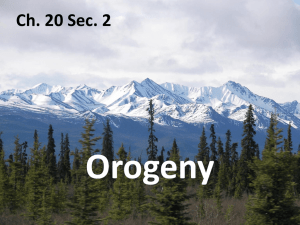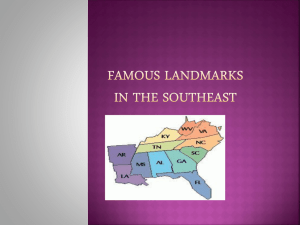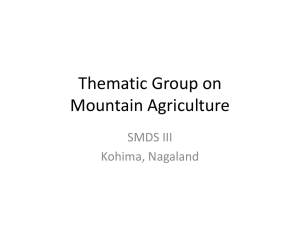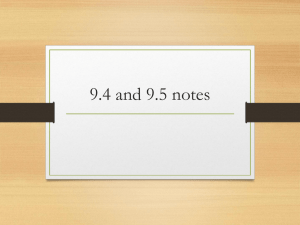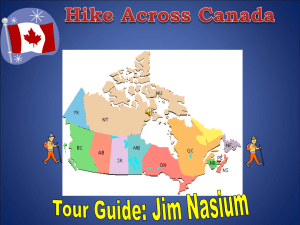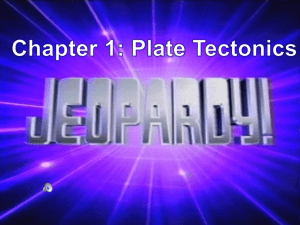mountain belt
advertisement
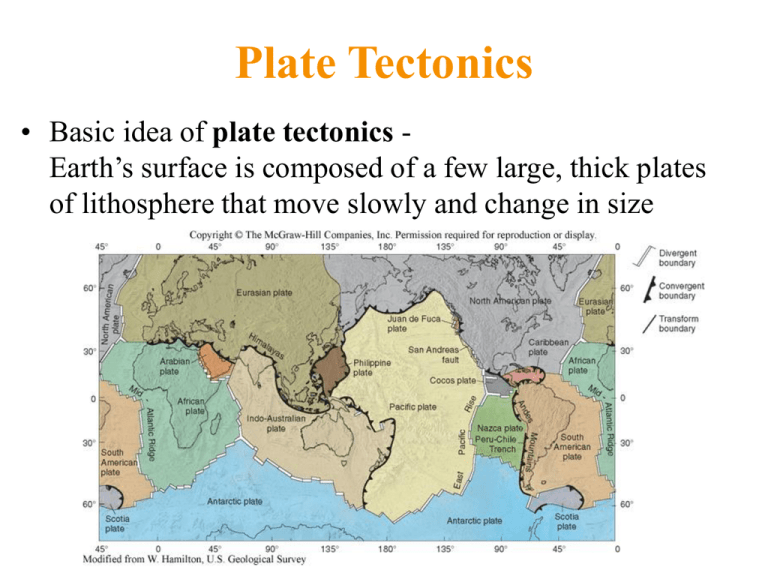
Plate Tectonics • Basic idea of plate tectonics Earth’s surface is composed of a few large, thick plates of lithosphere that move slowly and change in size Plate Tectonics • Intense geologic activity is concentrated at plate boundaries where plates move away, toward, or past each other • Combination of continental drift and seafloor spreading hypotheses in late 1960s Early Case for Continental Drift • Puzzle-piece fit of coastlines of Africa and South America Early Case for Continental Drift • In early 1900s, Alfred Wegener noted South America, Africa, India, Antarctica, and Australia have almost identical late Paleozoic rocks and fossils • Wegener reassembled continents into the supercontinent Pangaea Early Case for Continental Drift • Glaciation patterns Early Case for Continental Drift • Pangea initially separated into Laurasia and Gondwanaland – Laurasia - northern supercontinent containing North America and Asia (excluding India) – Gondwanaland - southern supercontinent containing South America, Africa, India, Antarctica, and Australia • Late Paleozoic glaciation patterns on southern continents best explained by their reconstruction into Gondwanaland Early Case for Continental Drift • Coal beds of North America and Europe support reconstruction into Laurasia • Reconstructed paleoclimate belts suggested polar wandering, potential evidence for Continental Drift • Continental Drift hypothesis initially rejected – Wegener could not come up with viable driving force – continents should not be able to “plow through” sea floor rocks while crumpling themselves but not the sea floor Paleomagnetism and Continental Drift Revived • Studies of rock magnetism allowed determination of magnetic pole locations (close to geographic poles) through time • Paleomagnetism uses mineral magnetic alignment direction and dip angle “frozen” into the rocks to determine the direction and distance to the magnetic pole when rocks formed – Steeper dip angles indicate rocks formed closer to the magnetic poles Paleomagnetism and Continental Drift Revived • Rocks with increasing age point to pole locations increasingly far from present magnetic pole positions Paleomagnetism and Continental Drift Revived • Apparent polar wander curves for different continents suggest real movement relative to one another • Reconstruction of supercontinents using paleomagnetic information fits Africa and South America like puzzle pieces – Improved fit results in rock units (and glacial ice flow directions) precisely matching up across continent margins Seafloor Spreading • In 1962, Harry Hess proposed seafloor spreading – Seafloor moves away from the midoceanic ridge due to mantle convection – Convection is circulation driven by rising hot material and/or sinking cooler material • Hot mantle rock rises under mid-oceanic ridge – Ridge elevation, high heat flow, and abundant basaltic volcanism are evidence of this Seafloor Spreading • Seafloor rocks, and mantle rocks beneath them, cool and become more dense with distance from mid-oceanic ridge • When sufficiently cool and dense, these rocks may sink back into the mantle at subduction zones – Downward plunge of cold rocks gives rise to oceanic trenches • Overall young age for sea floor rocks (everywhere <200 million years) is explained by this model Plates and Plate Motion • Tectonic plates are composed of relatively rigid lithosphere – Lithospheric thickness and age of seafloor increase with distance from mid-oceanic ridge • Plates “float” upon ductile asthenosphere • Plates interact at their boundaries, which are classified by relative plate motion – Plates move apart at divergent boundaries, together at convergent boundaries, and slide past one another at transform boundaries the Evidence of Plate Motion • Seafloor age increases with distance from mid-oceanic ridge – Rate of plate motion equals distance from ridge divided by age of rocks – Symmetric age pattern reflects plate motion away from ridge Evidence of Plate Motion • Mid-oceanic ridges are offset along fracture zones – Fracture zone segment between offset ridge crests is a transform fault – Relative motion along fault is result of seafloor spreading from adjacent ridges • Plate motion can be measured using satellites, radar, lasers and global positioning systems – Measurements accurate to within 1 cm – Motion rates closely match those predicted using seafloor magnetic anomalies Divergent Plate Boundaries • At divergent plate boundaries, plates move away from each other – Can occur in the middle of the ocean or within a continent – Divergent motion eventually creates a new ocean basin • Marked by rifting, basaltic volcanism, and eventual ridge uplift – During rifting, crust is stretched and thinned – Graben valleys mark rift zones – Volcanism common as magma rises through thinner crust along normal faults – Ridge uplift by thermal expansion of hot rock Transform Plate Boundaries • At transform plate boundaries, plates slide horizontally past one another – Marked by transform faults – Transform faults may connect: • Two offset segments of mid-oceanic ridge • A mid-oceanic ridge and a trench • Two trenches – Transform offsets of mid-oceanic ridges allow series of straight-line segments to approximate curved boundaries required by spheroidal Earth Convergent Plate Boundaries • At convergent plate boundaries, plates move toward one another • Nature of boundary depends on plates involved (oceanic vs. continental) – Ocean-ocean plate convergence • Marked by ocean trench, Benioff zone, and volcanic island arc – Ocean-continent plate convergence • Marked by ocean trench, Benioff zone, volcanic arc, and mountain belt – Continent-Continent plate convergence • Marked by mountain belts and thrust faults Movement of Plate Boundaries • Plate boundaries can move over time – Mid-oceanic ridge crests can migrate toward or away from subduction zones or abruptly jump to new positions – Convergent boundaries can migrate if subduction angle steepens or overlying plate has a trenchward motion of its own • Back-arc spreading may occur, but is poorly understood – Transform boundaries can shift as slivers of plate shear off • San Andreas fault shifted eastward about five million years ago and may do so again What Causes Plate Motions? • Causes of plate motion are not yet fully understood, but any proposed mechanism must explain why: – Mid-oceanic ridges are hot and elevated, while trenches are cold and deep – Ridge crests have tensional cracks – The leading edges of some plates are subducting sea floor, while others are continents (which cannot subduct) • Mantle convection may be the cause or an effect of circulation set up by ridgepush and/or slab-pull Mantle Plumes and Hot Spots • Mantle plumes – narrow, rising columns of hot mantle • Stationary with respect to moving plates Mantle Plumes and Hot Spots • Mantle plumes may form “hot spots” of active volcanism at Earth’s surface – Approximately 45 known hotspots Mantle Plumes and Hot Spots • Hot spots in the interior of a plate produce chains of volcanoes – Orientation of the volcanic chain shows direction of plate motion over time – Age of volcanic rocks can be used to determine rate of plate movement – Hawaiian islands Mountain Belts and the Continental Crust Physical Geology 12/e, Chapter 20 Introduction: Mountain Belts and Earth’s Systems • Major controlling factors during a mountain belt’s history • 1. Intense deformation • • • • Mainly compression Folds & faults Foliation & metamorphism Orogeny is an episode of intense deformation Major Mountain Belts • 2.Isostasy • Vertical movement before & after an orogeny • Continental crust “floats” on mantle • 3. Weathering & erosion • Depends on climate, rock type, elevation, etc. Andes Characteristics of Mountain Belts • Mountain belts are very long compared to their width – The North American Cordillera runs from southwestern Alaska down to Panama • Mountain belts in North America tend to parallel coast lines. Others, e.g. Himalayas don’t. • Older mountain ranges (Appalachians) tend to be lower than younger ones (Himalayas) due to erosion – Young mountain belts are tens of millions of years old, whereas older ones may be hundreds of millions of years old Schematic cross section through part of a mountain belt (left) and part of the continental interior (craton) The mountain belts and craton of North America Characteristics of Mountain Belts • Ancient mountain belts (billions of years old) have eroded nearly flat to form the stable cores (cratons) of the continents – Shields - areas of cratons laid bare by erosion Schematic cross section through part of a mountain belt (left) and part of the continental interior (craton) Satellite image of part of a craton in Western Australia Rock Patterns in Mountain Belts • Fold and thrust belts (composed of many folds and reverse faults) indicate crustal shortening (and thickening) produced by compression – Common at convergent boundaries – Typically contain large amounts of metamorphic rock False-color satellite image of part of the Valley and Ridge province of the Appalachian mountain belt, near Harrisburg, Pennsylvania Recumbent folds in the Andes Cross section of an “Andean type” mountain belt (oceanic-continental convergence) Rock Patterns in Mountain Belts • Erosion-resistant batholiths may be left behind as mountain ranges after long periods of erosion • Localized tension in uplifting mountain belts can result in normal faulting as a result of vertical uplift or horizontal Schematic cross section of a mountain belt in which gravitational collapse and spreading are taking place during plate convergence Rock Patterns in Mountain Belts – Horsts and grabens can produce mountains and valleys Fault-block mountains with movement along normal faults Evolution of Mountain Belts Orogenies & Plate Convergence • Mountains are uplifted at convergent boundaries during the orogenic stage – Result of ocean-continent, arc-continent, or continent-continent convergence – Subsequent gravitational collapse and spreading may bring deep-seated rocks to the surface Schematic cross section of a mountain belt in which gravitational collapse and spreading are taking place during plate convergence Evolution of Mountain Belts Orogenies & Plate Convergence • Orogenies & Ocean-Continent Convergence – – – – Cross section of an “Andean type” mountain belt (oceanic-continental convergence) Accretionary wedge Igneous and metamorphic processes Fold & thrust belts on craton (backarc side) Gravitational collapse & spreading Schematic cross section of a mountain belt in which gravitational collapse and spreading are taking place during plate convergence Evolution of Mountain Belts Orogenies & Plate Convergence • Orogenies and ContinentContinent Convergence – – – – – Figure 20.13 (Alps) Figure 20.14 (Himalayas) Continent crust too buoyant to subduct Suture zone Appalachian mountains (Alleghenian Orogeny) – Wilson Cycle is the opening & closing of ocean basins and continental collisions Evolution of Mountain Belts Post-Orogenic Uplift & Block Faulting • After convergence stops, a long period of erosion, uplift and block-faulting occurs – As erosion removes overlying rock, the crustal root of a mountain range rises by isostatic adjustment Isostasy in a mountain belt Development of fault-block mountain ranges Evolution of Mountain Belts Post-Orogenic Uplift & Block Faulting – Tension in uplifting and spreading crust results in normal faulting and fault-block mountain ranges – Horizontal extensional Development of fault-block mountain strain ranges – Isostatic vertical adjustment – Bounded on both sides by normal faults or tilted fault blocks The Teton Range, Wyoming, a tilted fault-block range Evolution of Mountain Belts Post-Orogenic Uplift & Block Faulting • Basin-and-Range province of western North America may be the result of delamination – Overthickened mantle lithosphere beneath old mountain belt may detach and sink into asthenosphere – Resulting inflow of hot asthenosphere can stretch and thin overlying crust, producing normal faults Upwelling, hot, buoyant mantle (asthenosphere) causes extension, thinning, and block-faulting of the overlying crust Delamination and thinning of continental crust following orogeny Growth of Continents • Continents grow larger as mountain belts evolve along their margins – Accumulation and igneous activity add new continental crust Geologic Resources Physical Geology, Chapter 21 Energy Resources Coal • Photosynthesis – CO2 + H2O → CH2O + O2 • • • • • Layer of peat being cut & dried for fuel on the island of Mull, Scotland Peat Lignite (brown coal) Subituminous coal Bituminous coal (soft coal) Anthacite (hard coal) Energy Resources Coal • BTU: British Thermal Units – Amount of heat energy to raise one pound of water from 62° to 63°F • Strip mining • Shaft & tunnel mining • Resource: total amount of any geological material of potential economic interest – Size of nonrenewable resource is fixed and theoretically determinable • Reserve: that portion of a resource discovered and economically & legally extractable – Size can change in time Energy Resources Petroleum and Natural Gas • Petroleum (oil) • Nutrient desert versus nutrient trap – Large rivers, less-evaporative climate • Buried hydrocarbons heated to break down (crack) – Anoxic environment – Isostatic subsidence – Sapropel • Burial – 2,300 meters (7,400 ft), 82°C (180°F) – Crack into petroleum • Deeper burial – 4,600 meters (15,000 ft) – Natural gas Energy Resources Petroleum and Natural Gas • Exploration • Source rock • Original sapropel • Reservoir rock • Usually sandstone or limestone • Permeable and porous • Structural (oil) trap • Anticline, pinchout, fault, unconformity, patch reef, sandstone lens, salt dome • Cap (trap) rock • Impermeable rock prevents further upward migration Energy Resources Petroleum and Natural Gas • Oil reservoir • Fluid pressure • Secondary recovery methods • Energy return on energy invested (EROEI) • Oil field: Regions underlain by one or more oil reservoirs Major oil fields of North America Energy Resources (Other Sources of Hydrocarbons) • Coal bed methane – Problem with salt water contamination – 700 tcf US (100 tcf recoverable) • Heavy crude & oil (tar) sands – Heavy crude is dense, viscous petroleum, uneconomical – Oil (tar) sands are asphalt cemented sand or sandstone deposits • Oil shale – Black/brown shale with high content of organic matter – Extracted by distillation – Green River Formation, 300-600 billion barrels recoverable Energy Resources (Other Energy Sources) • Uranium – 10% energy for US • Geothermal • Renewable Energy Sources – – – – Solar Wind Wave (tidal) Hydroelectric Metallic Resources • Ore: Naturally occurring material that can be profitably mined • Types of ore deposits – – – – – – Crystal settling within cooling magma Hydrothermal deposits Pegmatites Chemical precipitation as sediment Placer deposits Concentration by weathering and ground water Metallic Resources Ores Formed by Igneous Processes • Crystal Settling: Early-forming minerals crystallize & settle to the bottom of a cooling body of magma (differentiation) • Hydrothermal Fluids – Most important source of metallic ore (except Fe & Al) – Hot water & other fluids injected into country rock during last stages of magma crystalliztion – Atoms of Au & Cu (for example) don’t fit into crystals in cooling pluton concentrate in water-rich magma which is injected along with quartz into the country rock – Most are metallic sulfides mixed with milky quartz • Metallic Resources Ores Formed by Igneous Processes Four types of Hydrothermal ore deposits – (1) Contact metamorphic deposits • Iron, tungsten, copper, lead, zinc, & silver • Country rock may be completely or partially removed – (2) Hydrothermal veins: narrow ore bodies formed along joints & faults • Lead, zinc, gold, silver, tungsten, tin, mercury, and copper Hydrothermal quartz veins in granite Metallic Resources Ores Formed by Igneous Processes • Four types of Hydrothermal ore deposits – (3) Disseminated deposits: metallic sulfide ore minerals are distributed in very low concentration through large volumes of rock above & within a pluton • Copper, lead, zinc, molybdenum, silver & gold – (4) Hot-spring deposits – Pegmatites Metallic Resources Ores Formed by Surface Processes • Chemical precipitation in layers – Iron & manganese some copper – Banded iron ores • Placer deposits – Streams concentrated heavy sediment grains in a river, waves on a beach – Gold, platinum, diamonds, titanium, & tin • Concentration by weathering – Aluminum (bauxite) – Supergene enrichment of disseminated ore deposits 2,250 million year old banded iron ore

